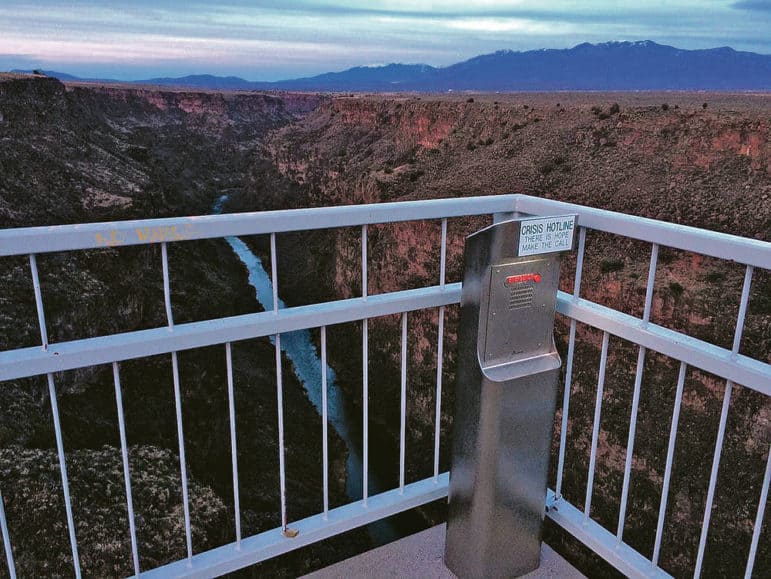
Taos News file photo
The New Mexico Department of Transportation installed 10 call boxes on the Rio Grande Gorge Bridge that connect to the New Mexico Crisis and Access Line. Some think that isn’t enough.
Perhaps the least rancorous debate of New Mexico’s legislative session ended Thursday with a unanimous decision that satisfied no one.
A committee of nine lawmakers from both political parties advanced a bill to spend $156,000 a year so state police officers can provide heightened security on the Rio Grande Gorge Bridge in Taos County.
Legislators on the House state government committee said they were not sold on the bill, which calls for three state police officers to be assigned to the bridge. But, the lawmakers said, they believed a significant number of suicides on the bridge makes the bill important enough to keep it alive in hopes that it can be refined later.
That means the measure, House Bill 166, will be considered later by the House Appropriations and Finance Committee.
In New Mexico, two vastly different reputations define the Rio Grande Gorge Bridge.
It is a place of breathtaking beauty, magnetic in attracting tourists and notable for inspiring artists.
But the bridge also is notorious in Taos, having been the site of dozens of suicides in the last quarter-century.
“It has caused a gray cloud in our community,” said Margaret “Curly” O’Connor, whose 23-year-old son, Cooper Beacom, jumped from the bridge to his death in 2014.
O’Connor and her younger son were on the bridge when Beacom took his own life.
“Had there been a railing that was taller, we could have pulled him down by his feet,” O’Connor said.
The railing is 47 inches high, she said, easy to clear if someone is in a frame of mind to kill himself.
She said her son had not exhibited any sign that he was suicidal before he headed to the bridge.
“He had struggled with alcohol, but had been sober for a year and half,” O’Connor said.
Then something went terribly wrong on the last day of his life.
“He went out and got drunk,” O’Connor said. Fueled by alcohol, Beacom became one of bridge’s fatality statistics.
Beacom’s death led his mother to form a group called the Gorge Bridge Safety Network. Its mission is to make the bridge safer and more inviting.
To that end, Taos-area residents have submitted proposals to the state Transportation Department for an array of physical improvements to the bridge and a lowering of the 45-mph speed limit along the span. One improvement on the bridge was the installation of emergency phones that enable distraught people to speak directly with mental health professionals.
Justin Young, owner of the Taos Cow ice cream shop and restaurant, employs O’Connor as his manager. He told the House state government committee that improving the bridge goes deeper than safety concerns.
“The issue is more than suicide prevention,” Young said. “The Gorge Bridge has become sort of a negative thing in our community. We need to make it a tourist attraction.”
He described the bridge as desolate, rather than a welcoming place for sightseers.
A committee member, Rep. Bill Rehm, R-Albuquerque, said one possibility is designating the bridge as a state park.
“We need to develop it,” Rehm said. “It’s an icon for the state.”
Making the bridge a state park also would give it more security without draining police manpower, said Rehm, a retired Bernalillo County sheriff’s captain.
He pointed out that the bill before the state government committee sought only $156,000 a year to pay for three officers to handle shifts on the bridge. But the fiscal analysis by the legislative staff states that an additional $132,000 would be needed annually to cover the salaries, benefits and equipment for three officers.
The Rio Grande Gorge Bridge is not alone in drawing the desperate and downtrodden who want to die. The same problem occurs at famous bridges across America.
San Francisco’s Golden Gate Bridge is installing a $200 million suicide barrier in hopes of saving lives. And in Pittsburgh, where bridges cover the city’s three rivers, a renewed intensity to dissuade jumpers took hold last summer. It happened after a Major League Baseball umpire bound for the ballpark persuaded a distraught woman not to leap off the Roberto Clemente Bridge.
Knowing other bridges attract suicidal people does not make life any easier for O’Connor.
For her, the Rio Grande Gorge Bridge has lost its charm and beauty.
But she has not lost hope that the bridge can be made safer.
The bill before the Legislature is not the solution, she said, but it is focusing people on the problem.
Contact Milan Simonich at msimonich@sfnewmexican.com or (505) 490-1048. Follow his Ringside Seat column in Monday’s and Friday’s print editions.